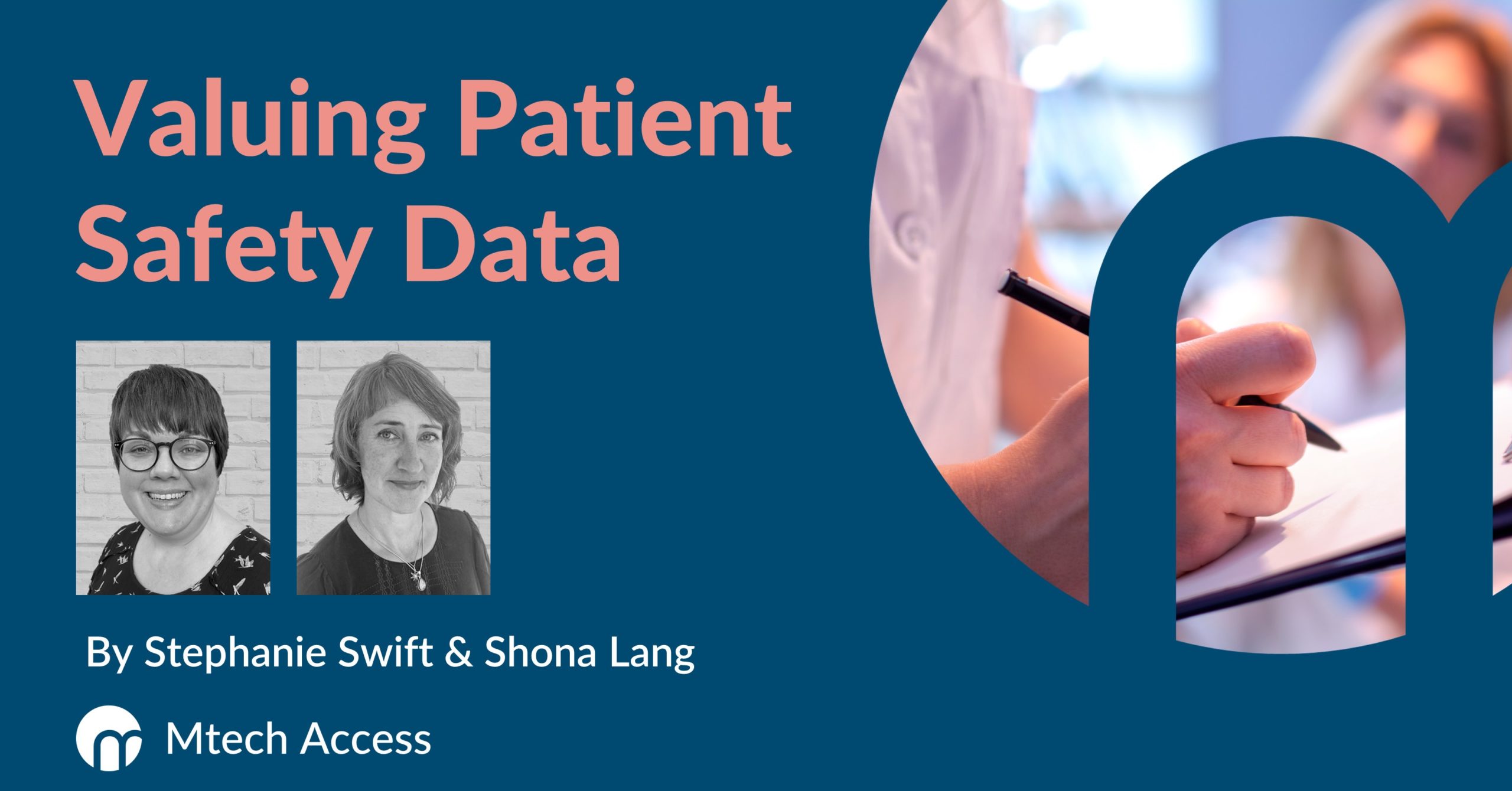
To celebrate World Patient Safety Day 2021, Dr Stephanie Swift and Dr Shona Lang, Consultant and Senior Consultant in Systematic Reviews and Evidence Synthesis at Mtech Access, highlight some of the changes, and ongoing struggles, to promote a balanced overview of efficacy versus safety in clinical trials.
How do clinical trials support increased patient safety?
Clinical trials are designed to assess the safety and benefits of any new interventions, such as drugs, devices, or diagnostic tests.
To protect the safety and wellbeing of patients, a trial must be approved by an ethics committee and be registered in the public domain before it begins.
Once a trial has finished, the results must be published, even if they are negative, to meet the highest standards of clinical trial safety and transparency. UK government guidelines currently suggest that trial results should be published within 6 or 12 months of the end of the trial for paediatric or non-paediatric studies, respectively (1).
However, not all clinical trials go on to publish their results. In the UK alone in 2019, 14% of trials run by NHS trusts and 31% of trials run by UK universities did not make their results public in any form (2, 3). This lack of clinical trial reporting has the potential to negatively impact patient safety, predominantly through a failure to publish important adverse event profiles.
Despite these ongoing challenges, there have been significant improvements in recent years.
Progress in the reporting of clinical trial evidence and patient safety data
The way that we value patient safety data that are captured in clinical trials has changed dramatically over the last few decades.
A more balanced overview of efficacy and safety
In the past, it was common for clinical trial publications to report the benefits of a drug in the main body of the manuscript, and report the potential risks, including safety and adverse event data, in the supplementary material. This created the impression that the safety of a new drug was not of equivalent importance to whether a new drug was efficacious at preventing or reducing disease.
Now, most journal publications address these issues at the peer review stage to create a more balanced overview of efficacy and safety prior to publication. However, it is still common to see adverse event data relegated to a small, succinct paragraph at the end of a results section rather than being comprehensively discussed.
Introduction of industry standards for collecting patient safety data
Historically, it was also extremely common for clinical trials to use ad hoc approaches to collecting patient safety data, which often missed important safety outcomes or led to incomplete reporting.
As a consequence, a set of in-depth standards to guide safety data collection in clinical trials were introduced and adopted from sources such as the International Council for Harmonisation of Technical Requirements for Pharmaceuticals for Human Use (4), the World Health Organization (5), and other independent agencies.
Updates to clinical trial reporting guidelines, such as the CONSORT extension for harms, have also provided an important guide for clinical trial investigators on best practices to improve the reporting of safety data and adverse events in randomised controlled trials (6).
Standardising adverse event definitions
Different clinical studies tended to develop their own custom definitions of adverse events, which meant that safety data could not be effectively compared between studies. To address this, core outcome sets have been developed that not only provide a standardised definition of key outcomes for clinical trials in particular disease areas, but also include the safety outcomes that patients consider to be the most important to them (7).
Supplementing clinical trial data with real-world evidence
Real-world evidence can be an important supplement to clinical trial data, since trials are frequently powered to support the primary efficacy outcome of the study but not to detect clinically meaningful adverse events.
Electronic health records and nationwide registries are valuable sources for surveying unanticipated or rare side effects (8).
Real-world evidence can also be important for highlighting what a patient actually prefers in terms of medication; they may prefer an injection to a cream, or a tablet to an injection. Safety issues relating to patient preferences are often not captured by trials and require additional study designs or the use of patient groups in clinical decision-making (9).
Patient Safety, Clinical Trial Data and Evidence Synthesis
As the quality and reporting standards of clinical trials have improved, so has the quality of the systematic literature reviews (SLRs) that include these trials as part of an evidence synthesis submission.
At Mtech Access, we have generated a wide range of SLRs for submission to health technology agencies, such as the National Institute for Health and Care Excellence (NICE) in the UK. Capturing patient safety data is a key part of this process to provide a balanced and integrated overview of the potential benefits and risks of a new drug in clinical practice.
We follow industry methodological and reporting standards to improve transparency, reduce bias, and create high quality SLRs to support a wide range of market access applications. We can also gather insights from healthcare providers and patient groups to support NHS integration.
How can clinical trials do more to support patient safety?
Clinical trial research has come a long way in improving the reporting of patient safety data, but there is still more work to be done to promote and highlight its value.
This includes areas such as the development of new legislation that requires study sponsors to publish full clinical study reports that provide individual patient safety data once a trial has concluded, and new initiatives to promote the publication of data from all clinical studies, even those that generate negative results.
Ultimately, this will improve patient safety standards even further and help to reduce research waste and duplication.
If you are considering a new regulatory submission that will include a systematic review of efficacy and safety data, please reach out for a free, no-obligation consultation at: info@mtechaccess.co.uk.
References
- Medicines and Healthcare products regulatory agency guidance: Registration of clinical trials for investigational medicinal products and publication of summary results. 2020. https://www.gov.uk/guidance/registration-of-clinical-trials-for-investigational-medicinal-products-and-publication-of-summary-results (Accessed 1st September 2021)
- org. Clinical trials run by NHS Trusts: £250 million at risk of becoming research waste. 2019
- org. Clinical Trial Transparency at European Universities. 2019
- International Council for Harmonisation of Technical Requirements for Pharmaceuticals for Human Use Efficacy Guidelines. Accessed 25th August 2021. https://www.ich.org/page/efficacy-guidelines
- World Health Organization. Handbook for Good Clinical Research Practice (GCP): Guidance for Implementation. 2005
- Ioannidis JP, Evans SJ, Gotzsche PC, O’Neill RT, Altman DG, Schulz K, Moher D. Better reporting of harms in randomized trials: an extension of the CONSORT statement. Ann Intern Med 2004; 141(10):781-788. doi: 10.7326/0003-4819-141-10-200411160-00009
- Heneghan C, Goldacre B, Mahtani KR. Why clinical trial outcomes fail to translate into benefits for patients. Trials. 2017 Mar 14;18(1):122
- Rudapatna VA, Butte AJ. Opportunities and challenges in using real-world data for health care. J Clin Invest. 2020;130(2):565-574. doi: 10.1172/JCI129197
- Cook NS, Cave J and Holtorf A-P. Patient Preference Studies During Early Drug Development: Aligning Stakeholders to Ensure Development Plans Meet Patient Needs. Front. Med. 2019 6:82. doi: 10.3389/fmed.2019.00082


